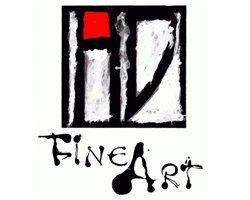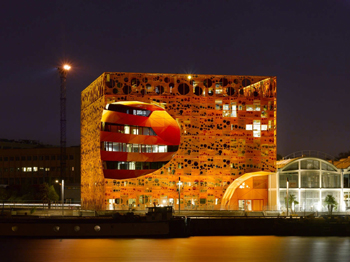Product Description
Forrest “Frosty” Myers Orange cube 2008


FORREST (FROSTY) MYERS (1941- ) USA
Orange cube 2008
Orange anodized and contoured aluminum wire manipulated into a cube form
Signed: Orange Cube, 08, Forrest Myers (on plaque)
For more information see: Who Was Who in American Art (Madison, Conn.: Sound View Press, 2003-2004 25th Edition), Dictionary of American Sculptors: 18th Century to the Present, Glen Opitz (Poughkeepsie, NY: Apollo, 1984).
Dimension: 10 1/2″ cube
Price: $15,000
A sculptor and art teacher born in Long Beach, California, Forrest Myers settled in Brooklyn, New York. Myers studied at the San Francisco Art Institute. His teaching venues include the San Francisco Art Institute, School of Visual Arts in New York, Kent State University, and the Parsons School of Design. His studio is in Brooklyn.
In the early 1980s, Forrest Myers was applying Buckminster Fuller's principles of tensegrity and repeated tetrahedrons into his designs for furniture. This exploration culminated in the use of aluminum wire that becomes structural when bent and pressed into a dense tangle.
Forrest “Frosty” Myers Orange cube 2008
ALYSSA MONKS (b.1977) USA
Push 2006
Oil on canvas
Signed: Alyssa Monks 2006 (on lower back of canvas)
Exhibited: DFN Gallery, New York 2006
Illustrated: American Art Collector, May 2006, p. 155
H: 30” x W: 56”
“Push” is somewhat of a response to the long tradition of bathtub paintings where a nude woman is displayed. However, the figure is me, the painter, so that the subject is also the artist, juxtaposing the objectification of women in that tradition. Also, the figure wears a black negligee and red lipstick, white makeup gently drips down the cheek, closing the door on naturalism.
At the New York Academy of Art, Alyssa Monks studied with Vincent Desiderio, Wade Schuman, Brenda Zlamany, John Jacobsmeyer, Harvey Citron, Deane Keller, Edward Schmidt, Steven Assael, Lisa Bartolozzi, Patrick Connors, Peter Cox, Jon DeMartin, Leonid Lerman, and Hong Nian Zhang. Alyssa’s sensibility of paint and color allows one to be seduced into the illusion of each image. Striving for anatomical and realistic accuracy, it is her intention to elicit a serious confrontation. The work requires attention to detail and a slow and rich execution. It is this artist’s concern to visually relate the contemporary human experience with sensitivity, empathy, and integrity.
HUBERT SCHMALIX (1952-) Austria
Häuserbild 1989
Oil on canvas
Signed and dated on back: Schmalix 89
Exhibited: Galerie Krinzinger Vienna 1990 (Solo exhibition)
Illustrated: Nach Schiele, Tobias G. Natter and Thomas Trummer (Köln, Germany: Atelier Augarten, DuMont, 2006), p 142.
Provenance: Private Collection Vienna
For related works by Hubert Schmalix see: Hubert Schmalix, Lóránd Hegyi exhibition catalog (Museum Moderner Kunst StiftungLudwig Wien) November 19, 1994 – January 1995.
H: 85” x W: 49”
Hubert Schmalix was born in Graz, Austria, on December 17, 1952 and studied at the Vienna Art Academy from 1971 to 1976. By 1979 Schmalix was showing work at the forward-looking exhibition ‘Europa 79 – Kunst der 80er Jahre’ in Stuttgart. In 1983 the London Tate Gallery invited Schmalix to present work at ‘New Art’, an important survey of contemporary art. Schmalix has become well-known world-wide as an exponent of ‘New Art’, working with a retrospective glance at both classical art history and modern art. Schmalix focuses on the world of things and the human figure. Although the expressive gesture was the dominant feature of his 1980s work, it yielded early in the 1990s to stringent tectonic composition. In 1984 Hubert Schmalix went to the Philippines and on to the US, moving to Los Angeles in 1987. In 1986-87 Schmalix taught at the Academy for the Decorative and Applied Arts in Vienna and from 1997 he has been a professor at the Vienna Art Academy. Schmalix is a visiting professor at the University of California Los Angeles (UCLA). In 1993 his work was featured at the Venice Biennale and in 1998 he was awarded the Fine Art Prize of the City of Vienna. Schmalix has done several large fresco cycles in Salzburg and his work has been shown extensively at numerous international solo and group shows and most recently at Art Basel 2006.
The Kunstforum in Vienna is dedicating a major retrospective show to Hubert Schmalix from May 6th – July 12th, 2015.
“I’m not nervous or angry when I paint, but well rested and concentrated. Each stroke of the brush is important! I’ve painted a whole lot of beautiful pictures this way.” (Hubert Schmalix)
